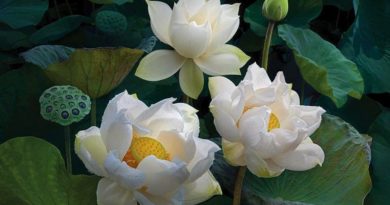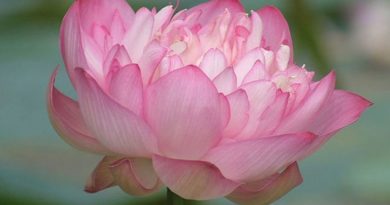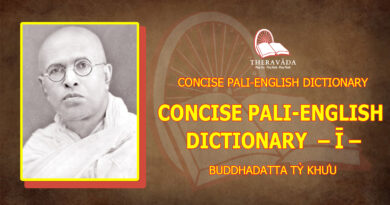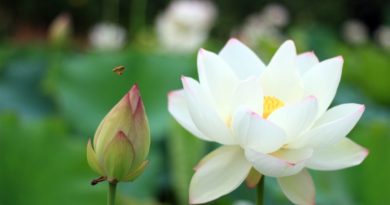TRANQUILLITY AND INSIGHT
TRANQUILLITY AND INSIGHT
Venerable Acariya Maha Boowa Nanasampanno
Translated by Bhikkhu Thanissaro (1998)
People for the most part look after their bodies without looking after their minds. This is why, even though they may experience physical pleasure to some extent, they don’t have much mental pleasure to speak of. The major factor, the mind, rarely feels pleasure even when there’s pleasure in the minor factor, the body. The body is a minor factor when compared to the mind. The mind is the major factor in each person, but instead of taking good care of this major factor, this basis for the body, we hardly ever look after it at all.
If the mind were not more solid and lasting than the body, it would have disintegrated long ago and wouldn’t have been able to oversee the body as long as it has. But the reason it has been able is because it is very solid and lasting enough to stand up to the onslaught of the various things that are always coming into contact with it — namely the sights, sounds, smells, tastes, and tactile sensations that come flowing in through the eye, ear, nose, tongue, and body. They gather in at the mind in the same way that all rivers flow together and gather in the sea.
All sorts of worthless and filthy preoccupations come flowing into the mind at all times, turning it from something precious into a trash can. This is why we can’t find any marvels, any happiness in it at all. So to receive training in the Dhamma of the mind is something very important for this major factor within us. If the mind has Dhamma and reason within it, then whatever it displays in word and deed is correct and good and seldom ever falls off target. Whatever our actions, they’ll seldom fall off target. The heart will be happy and the body quite normal. If diseases arise in the body, they won’t cause any trouble that will have an effect on the mind or create any sort of mental illness within it. But when defilements fill the heart, they make it troubled and upset. If we simply complain about the effects without removing the causes, it won’t serve any purpose at all. For this reason, the right way to act is to make sure you don’t waste your birth as a human being. How many years have passed from the day of your birth up to now? How many months and years have you experienced? How much work? How much suffering? How much have you gained from all the various things you’ve encountered? Have you ever tallied these things up to see how much you’ve profited or lost? When you leave this life and head for the next, what will you have to hold on to as basic provisions for what lies ahead?
The work of the world is something you can do until you die and you’ll never come to the end of it. No matter what, you’ll have to let go of it and die. The day you die is the only time you’ll be free as far as the work of the world is concerned. This is the way it is for everyone. No matter who we are, no matter where we live, none of us is free. We’re only free to die. Why? Because death transcends all our work, which has to be abandoned at the moment of death.
If we wait for free time in which to provide for the mind, we’ll never be free until the day we die. That’s when we’ll be free — free to die. So while we’re still alive and able to think things through both within us and without, we should hurry and make an effort in all activities that will be to our benefit. There is still time to start, and in particular, to meditate. This is an extremely important food and sustenance for the mind. It’s called Dhamma — Dhamma medicine — medicine that can cure the mind of its restlessness and anxiety, giving rise instead to the pleasure of peace because we have the food of the Dhamma to nourish us.
As the first step in training the mind, we’re taught to choose one ‘Dhamma theme’ (kammatthana)or another as a means of controlling and looking after the mind. Otherwise, it will go straying off to its old habitual occupations and cause suffering and discontent to the point where we’re constantly disturbed and distracted. This is why we’re taught to meditate on ‘Buddho, Dhammo, or Sangho,’ to be mindful of the breath, or to combine ‘Buddho’ with the breath, thinking ‘Bud’ with the in-breath and ‘dho’ with the out-breath, whichever theme seems most suited to our temperament. In focusing on these things, you should focus your awareness exclusively in the heart. For example, when you focus on the inand- out breath, make yourself aware of each time the breath comes in and each time it goes out until the end of the time you’ve set to meditate. You can focus on the feeling of the breath at any point that seems most prominent in your awareness. Whichever point the feeling of the breath is clearest — such as the tip of the nose, for example — is the point you should focus on, the point you should be mindful of. Make sure you know when the breath comes in and when it goes out. If you want, you can combine it with ‘Buddho’, thinking ‘Bud’ with the in-breath and ‘dho’ with the out-breath. Keep your attention exclusively with the breath. You don’t have to go thinking about any other issues outside of the work you’re doing — focusing on the breath — right now in the present.
This way, as mindfulness gradually becomes more steady and continuous, the mind won’t have any chance to slip out after the various preoccupations that can cause it harm. It will settle further and further into stillness. At the same time, the breath — which was coarse or blatant when you first began focusing on it — will gradually become more and more refined. It may even reach the stage where it disappears altogether from your sense of awareness. This is because it’s so refined — so refined that it disappears. At that moment there’s no breath and only knowingness remains. This is one of the things that can happen in your meditation.
The heart at that point is very quiet and very amazing. The breath has disappeared without leaving a trace, and the body disappears at the same instant. What this means is that it disappears in your sense of feeling, not that the actual body goes away anywhere. It’s still sitting right there, but your awareness isn’t involved with any sense of ‘body’ at all. It’s simply knowingness pure and simple, entirely on its own. This is called ‘a quiet mind.’ The mind is its own self on this level and it develops a strange, uncanny, and amazing feeling of pleasure.
As soon as the mind becomes quiet and disentangled from all activities, there’s no sense of time or place, because the mind isn’t giving meaning to anything with thoughts of time or place. There’s simply knowingness maintaining itself in that state. This is the feeling of pleasure that can come from meditation. You can, if you want, call it one of the fruits of meditation.
As for those who repeat ‘Buddho’ as their theme, the same sort of thing happens. If you focus on ‘Buddho’ without coordinating it with the breath, simply be aware of each repetition of ‘Buddho, Buddho, Buddho’. You don’t have to go thinking about how the results are going to appear. Maybe someone has tried to scare you, saying, “Watch out. If you meditate, you may get a vision like this or like that, and then you’ll go crazy.” There are lots of people who say this sort of thing, but for the most part they themselves have never meditated. They just like to go around saying these things to scare those people who are all too ready to believe this sort of thing, because they’re people of the same sort — quick to believe these things, quick to get scared, quick to find excuses for being lazy so that they end up never meditating at all. So watch out for people like this, because there are all sorts of anti-Buddhists lurking around in Buddhist circles. Don’t say I didn’t warn you.
People with principles, who have seen, as a result of meditation, the relationship of cause and effect within themselves won’t believe these sorts of comments. Why? Because the Buddha, in teaching the world, wasn’t teaching it to go crazy. He wasn’t a crazy teacher, so how could he teach the world to be crazy? When people who practice the Dhamma follow it correctly in line with the principles he taught, how can they go crazy? It’s out of the question. So don’t be fooled into believing such things or you’ll miss out on a precious opportunity.
Now, it can happen that people do go crazy when they meditate because they deviate from the Dhamma and let their minds stray away from the principles taught by the Buddha. For example, while they’re repeating ‘Buddho, Buddho, Buddho’ to themselves they send their minds out to see this or know that, and then get so carried away with what they see that they forget their meditation-word and start believing their visions. When this happens, it can lead to bad results. Yet even though people like this go crazy because they’ve deviated from the principles of meditation and the principles of the religion, other people take it as an excuse to go around criticising the religion and saying that meditation will make you go crazy.
Actually, when you meditate there’s nothing much you have to do. Simply focus on repeating ‘Buddho, Buddho, Buddho’ in the mind. You don’t have to paint pictures in your imagination that heaven is like this or nibbāna is like that, that heavenly beings are like this or that, as you’ve learned from books. People who have actually seen heavenly beings have seen them with their intuitive knowledge in line with the principles of their knowing nature, but we see them only through our imagination, speculation, and guesswork. Sometimes we actually fool ourselves with our own picture painting, because we like that sort of thing, and once we fool ourselves the result is craziness — a mind wild and restless, with no Dhamma principles to hold to. Some people of this sort actually go insane, so this is a potential pitfall we should watch out for.
Thus you shouldn’t speculate about results at all. Simply work away at the repetition of your meditation-word. This is the work that, once it becomes continuous, will gradually produce results, step by step. There’s no time or place that will give rise to results while you meditate unless you do the work, that is, unless you think of your meditation-word in this way.
This is the important principle that underwrites your meditation. If your mind and meditation-word keep in contact with the breath, you can be sure that nothing frightening or unnerving will happen. The lies that people who have never meditated may tell you about meditation are simply a smokescreen, that’s all. There’s no truth to them. The truth is what I have told you just now in line with the principles of the Dhamma which the Buddha taught. So begin meditating in the way I’ve explained, and you won’t go crazy. Instead, you’re sure to gain nothing but knowledge in dealing both with your inner and your outer activities — and at the same time, you’ll develop splendour in your heart.
As for those who practice mindfulness of breathing, there’s one important point I haven’t yet fully explained. That is when you meditate to the level where the breath becomes refined — more and more refined, more and more refined — and the mind is aware of it stage by stage to the point where the breath disappears, leaving nothing but knowingness pure and simple. It may happen that at this point you start to get worried, which is another way you can fool yourself. So I’d like to insert a few remarks here so that you’ll understand.
When it happens that the breath disappears from your sense of awareness, you might begin to worry: “If the breath disappears, won’t I die?” If you think this you’re fooling yourself, because when this happens you’re sure to become afraid that you’ll die, with the result that the breath immediately reappears. That’s as far as you’ll get and things won’t get any more refined than that. So to get past any obstacle created when the breath disappears during your meditation you should tell yourself that: “Even though the breath may disappear, the mind is still here with the body, so I won’t die.” This is enough to get rid of the problem of your fear of death at that point, which is simply a momentary distraction.
Actually, when you fall asleep, which is similar to dying, you don’t pay any attention to whether or not the breath disappears — and you don’t die. When you meditate, your awareness is much more alert and refined than that; you know that the breath has disappeared because of the alertness of your meditation, so you should be even more discriminating than when you fall asleep — instead, you get afraid! This shows that you’re not up on the tricks of the defilements.
So to be up on their tricks, you should remind yourself of the truth: “The breath has disappeared, but the mind is still with the body, so I won’t die.” Just this is enough to make the mind break through to a more refined level where the whole body disappears together with the breath. The defilements won’t impinge on your awareness at all. This is called reaching the point of refinement in breathing meditation. Some people can stay at this level for hours, others don’t stay very long. It all depends on the strength of the individual meditator.
What you’ll gain as a result in that moment is the refinement of the mind that is simply aware, all by itself — simply aware of itself at that moment, not involved with any preoccupations at all. This is called ‘one-pointedness of mind.’ If the mind isn’t involved with any object at all, so that only knowingness remains, that’s called one-pointedness. It is at one with the knowingness, not paired with any object or meditation-word at all, because at that point it has completely let go of its meditation-word. All that remains is the knowingness staying there by itself. This is called one-pointedness of mind.
This is the way meditation develops as it becomes progressively clearer and clearer to the heart of the person doing it. If you actually follow the principles of the Lord Buddha’s Dhamma, there’s nowhere else you can go. You’ll have to come to the truth. In other words, the results you receive will have to follow in line with the causes you’ve practised correctly. However much pleasure you receive when the mind settles down, it will immediately hit you: “This is what pleasure is” — because the pleasure you feel in the heart at that point is unlike any other pleasure you’ve ever experienced. It’s a pleasure more uncanny and amazing than any other pleasure in the world.
This is why the religion has lasted up to the present. If it weren’t for this, it would have vanished long ago, because its flavour would have been no match for the flavours of the world. It wouldn’t have had any solid worth, any marvels to compete with the world at all. It would have folded up long ago because no one would have been interested enough to keep it going up to the present. But the fact that it has lasted is because it’s more worthwhile than any of the worlds on the three levels of the cosmos. Even just the stage of the quiet mind lets us see something of the marvels that lie within us, in our bodies and minds. Never before have we ever seen the strange and amazing things that come from that quietness, but now that we’re meditating and the mind becomes quiet, there they are!
And now that these results appear, we start becoming persistent. We make the effort. We have the time — all of our own accord — because we’ve gained conviction from the results we’ve clearly seen. Now the question of finding time, finding a place to meditate or quiet the mind or make an effort in the area of the mind, is no longer a problem. Once the mind is content to do these things, it finds time for these things of its own accord. This is one step in the course of meditation. This is the way it is when we meditate. We have to practice so as to reach the level of meditation where the mind becomes still.
Next comes the level of wisdom. This is genuine ‘insight meditation.’ It’s a common expression among people that they’re going to practice insight meditation, or vipassanā. Actually, vipassanā means clear insight that comes from having investigated with wisdom. The word meditation covers both tranquillity and insight meditation, but usually we say we’re going to practice vipassanā or insight meditation when we actually mean simply that we’re going to meditate.
Actual insight meditation means to contemplate and investigate. Once the mind becomes quiet and peaceful, it’s bound to develop approaches to use when we make it investigate and analyse the physical properties and khandhas, or the topics of impermanence (anicca), discontent (dukkha) and not-self (anattā). We’ve read in the texts that: “Wherever there is impermanence, there is discontentment. Wherever there is discontentment, there is not-self.” We’ve seen other people grow old, die, and be separated from their loved ones — but we should realise that we too are subject to separation, we too are impermanent, discontented, and not-self just like them. We have to bring these truths inward to ourselves. We grow older day by day, day by day. From the day of our birth we’ve kept growing progressively older and older, changing step by step. This is called impermanence.
Pain and suffering have stuck right with us ever since the day we were born. The moment we came out of the womb, we fell unconscious. We were in shock because the pain was so great. Some infants die in the womb, some die the moment they leave it because they can’t take the great pain. Pain and suffering have been right here with us, from the time we were small up to the present — so where are we going to harbour any doubts about impermanence, discontentment, and not-self? These things are heaped on top of us in full measure at all times.
Impermanence means changing with every moment. Even now, you’ve been sitting here for just a little while and already you’re tired. The body has changed. It’s changed from what it was and has begun to ache.
Not-self. What in the body and the khandhas can you hold to as having any lasting worth? The body is simply an assemblage of the four properties of earth, water, wind, and fire — that’s all. As for the khandhas, there are five. Khandha means group, heap, or assemblage. The first khandha, rupa, refers to the body. Vedanā ā refers to feelings of pleasure, pain, or neither pleasure nor pain. These are another group or heap. Saññā refers to memory which bestows significance and meaning on things. Sankhāra refers to thought and imagination. Viññāna refers to consciousness arising whenever the eye meets with a visual object, the ear meets with a sound, and so on. Altogether, these things are called the five heaps. So where is there anything of substance in these five heaps to which you can hold to, saying: “This is me?”
This is what insight meditation is — separating things out to find the truth, the truth in our own bodies and minds. But because we’re ignorant and unable to see the truth, we say that “This is me … That’s mine.” When any of these things change, we become sad, upset, and depressed. There are lots of people who become mentally ill because their thinking goes all out of bounds. ‘Mental illness’ here means the mental distress or turmoil we all suffer from, not necessarily the heavy mental illnesses where people lose their senses and go out of their minds. When we investigate, separating the properties and khandhas with our wisdom in this way, we’ll see that our wisdom can develop techniques and approaches capable of cutting away defilements stage by stage, until they can cut away all defilements connected with the five khandhas.
When we say “That’s me … This is me,” it’s because the mind and the khandhas seem to be one and the same, so we can’t tell them apart. When wisdom has analysed and investigated them through the power of the knowledge it has developed to a high level of proficiency, it can tell these things apart. It knows: “This is the body … This is feeling … This is memory … This is thought … This is consciousness.” The body is the body, this thing is this thing, that thing is that — but we’re not this or that thing. We can tell them apart and separate them out step by step, until we can separate the heart out from the defilements and effluents (āsava) that lie buried within it, and there’s nothing at all left in the heart. This is where it’s called truly ‘Buddho’. The result of practising meditation, when we reach the final stage, is that the heart becomes truly ‘Buddho’, just like the ‘Buddho’ of the Lord Buddha. This doesn’t mean the same ‘Buddho’ as his. Instead it means that in comparing them, the purity of ours is equal to the purity of his, but that his range as a Buddha is greater than ours as disciples, in line with the greater power of his potential and capabilities, which are issues outside the question of purity.
A person’s capabilities can be known by hearing his teachings. The Buddha’s knowledge has to be in line with his level, while that of the disciples is fully in line with theirs; but as for the question of purity, they are all equals. The Buddha taught: “There is nothing superior to one with no evil.” From the Buddha down to his final Arahant disciple, their purity is equal, with no gradations at all. Right here is where the similarity lies. This is the result of developing the mind through meditation. We practise it step by step, removing defilements step by step until they are all absolutely gone, leaving nothing but purity. This purity is what experiences the ultimate level of happiness. There is nothing higher than this form of happiness. It’s called the highest transcendent quality, a quality transcending the world. “Transcending the world” means that it transcends the physical properties, transcends the khandhas, transcends everything. There is nothing superior to this thing that is pure. This is the fruit of meditation. The Buddha attained it before anyone else in the world in those days, and has led the way for all Buddhists who practice in his footsteps, down to those of us practising right now.
The Buddha taught the religion reasonably, in terms of cause and effect. We should follow in line with the principles he taught, and the effects — the results — are sure to appear accordingly. Where the causes exist, the results have to appear. If people practice correctly and in line with the Dhamma principles he taught, how will they not meet with the results?
The Dhamma is a well-taught Dhamma, not an empty-handed one, so how can those who practise it not reap results? When they say that the paths (magga), fruitions (phala) and nibbāna have disappeared, where have they disappeared? — aside from disappearing from those who aren’t interested in the practice. Even in the time of the Buddha, these things didn’t exist for those who weren’t interested. But they did exist for those who were interested and practised in line with the principles the Buddha taught.
The same holds true for the present. The middle way is always right in the centre of the truth, right on-target, always appropriate for removing defilements. No matter which defilement, no matter what sort, it can never escape the power of this middle way. This is why this way is a Dhamma absolutely right for removing the defilements of the beings of the world. It’s called the middle way. The middle way now and the middle way of the Buddha’s time — how can they differ? There’s no difference between them at all, because they’re the same well-taught Dhamma. The defilements are the same now as they were then. The middle way, the tool for removing them, is the same now as it was then. When we use it to eliminate the defilements, how can they not fall away? The power of our correct practice in line with the principles of the middle way will have to give the same results now as it gave then.
But the paths, fruitions, and nibbāna don’t exist for those who don’t practise, no matter what the time or era. They exist only for those who practise, and they appear in greater or lesser meas- ure in line with the strength of each individual’s practice. That’s all there is to it.
This is called the well-taught Dhamma, the Dhamma that leads those who practice it away from suffering and discontent, step by step, until they are absolutely released. There is nothing to surpass the Dhamma of the Buddha in completely removing defilements from the heart. This is why we can be confident in our practice.
There is no one in the world who can speak more correctly and accurately than a teacher with no more defilements, a teacher who speaks entirely from the truth. The Buddha never spoke dishonestly or deceptively in the way of the world, for things like deception are an affair of defilements. The Dhamma is something that has to be spoken forthrightly, straightforwardly, in line with the truth. When people practice in line with the truth, how will they not know the truth? They have to know. This is where the greatness lies. It doesn’t lie anywhere else. So don’t go doubting and groping around like blind people oblivious to the Dhamma, the Buddha’s representative, filling our nation.
In conclusion, I ask that you all take this and think it over. If anything I have said here is too hard-hitting for your ears or hearts, I ask your forgiveness, because today’s Dhamma has been ‘Forest Dhamma’ [*]. I hope it will be at least of some use to you all.
[*] Dhamma learned from the practice, rather than from the study of books.
-ooOoo-
Source: Budsas.org







